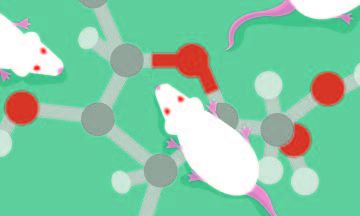High-fructose diets leaves mice absent-minded

High-fructose diet leaves mice absent minded
October 27, 2014
In a Barnes maze, under a bright overhead light, rats make their way around a surface resembling a round dining table ringed with holes—each one a potential “escape box”—and use cues to search for shelter from the glaring bulb.
To better understand the cognitive effects of added sugar in the diet, a recent study published Oct. 3 in the journal Hippocampus, placed adolescent rats into the Barnes maze after being fed a diet that included a large amount of sugar. The young rats experienced impairment of their spatial learning and memory functions as well as other negative metabolic outcomes.
Researchers at the University of Southern California gave adolescent and adult male rats access to food, water and either an 11 percent solution of sucrose—table sugar—or HFCS-55, a commonly found concentration of high fructose corn syrup, for 30 days. In the adolescent rats, HFCS intake impaired their ability to navigate the maze, with moderate impairment also observed in the table sugar group.
According to Scott Kanoski, assistant professor of Biology at the University of Southern California and co-author of the study, it is difficult to say that adolescent rats were affected differently
than adults.
“We hypothesize that adolescents—like in any other period of rapid growth or maturation—are [in] what we call critical developmental periods where behavioral and biological systems are highly suspect to being influenced by environmental factors,” Kanoski said. “For example, the prenatal period is one of high susceptibility to dietary metabolic effects.”
It is well established that in both human and rodent populations, the consumption of excess sugar can lead to unwanted metabolic effects like weight gain and impaired blood glucose regulation in addition to the spatial memory impairment documented in this research, Kanoski said.
“The hippocampus is necessary for episodic memory, the memory we use in our daily lives,” said Rebecca Burwell, a professor in the Department of Cognitive, Linguistic and Psychological Sciences at Brown University, referring to the brain structure associated with memory. “Spatial memory is like a special case of [episodic memory]. It’s almost a model for it.”
According to Burwell, episodic memories incorporate places into memories and associate them with specific times. In the Barnes maze, the animal is using a cognitive-spatial map that has other elements hooked into it, episodes that are different but share similar elements that link them together.
“If you remember where you were on your birthday, memories from the same place might be triggered,” she said. “But it could also trigger other birthdays or memories of the people you were with. It doesn’t have to be a spatial link.”
Kanoski said although the behavior of the mice that ingested either the fructose or sucrose was significantly worse than that of the control group, he suspects the impairment would not be as profound as it would be in a mouse that had physical damage to its hippocampus.
In an April 2012 study published in the Journal of Physiology and co-authored by Fernando Gomez-Pinilla, professor of neurosurgery and integrated biology and physiology at the University of California at Los Angeles, it was found that rats fed a high-fructose diet for six weeks experienced detriment in many systems important for brain function. Gomez-Pinilla said this effect was amplified by a deficiency of omega-3 fatty acids in the diet.
“The significance is that people need to think about the whole diet in terms of how to combine nutrients for better outcomes,” Gomez-Pinilla said. “The types of memory being affected are connected to disorders like Alzheimer’s disease.”
Gomez-Pinilla said the establishment of a baseline metabolic syndrome in the body causes the brain and the body to operate at a deficit and is significant considering that in 2012, the average American consumed nearly 30 pounds of HFCS, according to the Economic Research Service.
Researchers from USC also noted that the HFCS group showed increased levels of certain inflammatory proteins produced by cells in the hippocampus to regulate immune responses compared to the control group. However, insulin levels were elevated for both sweetener-exposed groups of young mice.
“[In follow-up studies,] we hope to look at whether the type of sugar is an important factor in mediating these effects,” Kanoski said. “We want to see if the results can be programmed and they will be if the sugar stimulus is removed later in life and determine the impact of consuming added sweeteners during adolescence.”







